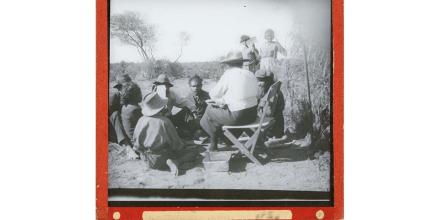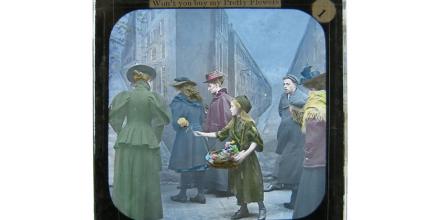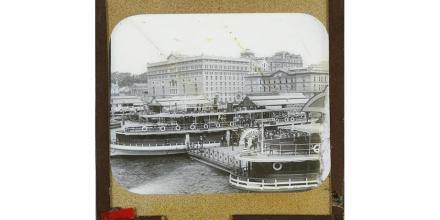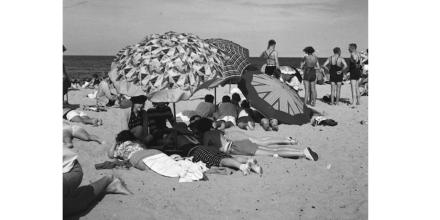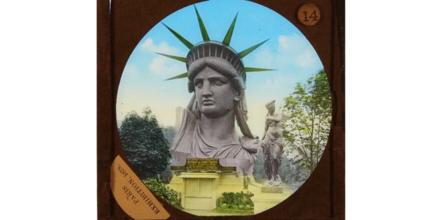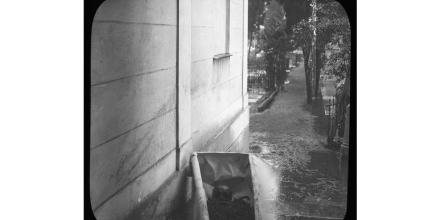My Favourite Slides
Daisy Bates - Discussed by Nicolas Peterson
Daisy Bates - Discussed by Nicolas Peterson The red border first drew my attention to this slide that was housed with a large collection of others. The slides apparently belonged to an academic at the University of Adelaide and a number of them were labelled as from the west coast of South Australia. So the identification of the woman with her back to the camera as Daisy Bates makes sense as does the context, and the dress. Daisy Bates was a woman of Irish background, a journalist, ethnographer, and welfare worker with a life long interest in Aboriginal culture. She…
Won't You Buy My Pretty Flowers - Discussed by Martyn Jolly
Won't You Buy My Pretty Flowers - Discussed by Martyn Jolly Here is a new set of life model magic lantern slides I have just acquired. I love the twin perspectival vanishing points of the first painted backdrop, the photogrammed snow flurries in slide two, and the weirdly frozen Beckettian choreography of the passers-by in the final slide. They were made by Bamforth and Co after 1897 in the UK. The song originates from the US in 1877 and is by George W Persley, Arthur W French, George Clare. (Although interestingly it was re-published in 1887 under the names of …
Circular Quay Sydney - Discussed by Elizabeth Hartrick
Circular Quay Sydney - Discussed by Elizabeth Hartrick The Customs House clock shows 10 minutes to 2 in the afternoon. But, when was the photograph in this slide taken? Is it a Saturday? Who are those people disembarking at the Quay and where are they going in such a hurry? The Penny Ferry’s just arrived, men in neat suits and natty boater hats are making their way off the upper deck down a staircase that covers the great paddle wheel. One chap breaks into a trot to beat the rush coming off the lower deck, another taking a short-cut by jumping the railing and leaping directly onto the wharf…
Henri Mallard's 'Collaroy' - Discussed by Art Gallery of New South Wales Resources Librarian Eric Riddler
Henri Mallard's 'Collaroy' - Discussed by Art Gallery of New South Wales Resources Librarian Eric Riddler New Year’s Day, 1935, and the beach at Collaroy is crowded with colourful beach umbrellas and daring backless swimsuits for both women and men. Not everyone is joining in the backless craze. Several of the beachgoers are wearing cardigans and pullovers, belying an unseasonably mild January day (not getting above the low twenties Celsius, according to the Sydney Morning Herald [‘Meteorological reports’, 2 January 1935, p 11]). Tellingly, there seem to be few beachgoers actually in the…
Franco-American Statue of Liberty - Discussed by Partner Investigator, Joe Kember
Franco-American Statue of Liberty - Discussed by Partner Investigator, Joe Kember Having spent quite a bit of the last two years investigating slide series in museums throughout the UK, I have come to the conclusion that, by and large, my favourite slide sets are life model series. I especially love the staging of the models, which in large manufacturers like York and Son are often cleverly handled to express sentimental nuances that must have been important in the course of the show. In less expansive outfits, like T.T Wing’s small slide production facilities in Cambridgeshire, I also…
Cyclo-Creatia Ethnographica – Discussed by Bruno Jordanoff
Cyclo-Creatia Ethnographica – Discussed by Bruno Jordanoff Elisa deCourcy and Martyn Jolly had a fascinating conversation with Bruno Jordanoff, and the following is based on that conversation I was born and spent a fantastic portion of my life growing up in the Kimberley, so I have always found myself drawn to collecting many forms of physical, visual and aural artifacts relating to the region. Early in 2013 I procured a lantern slide which, based on other examples I had seen, I believed would have been in circulation around the 1920-30s. The slide was labeled 'Y33'. I guessed from the…
The Exhumation of James Smithson - Discussed by one of our project's Chief Investigators, Associate Professor Martin Thomas
A man – or the remnants of one – stares from his coffin. The cranium with its cavernous eye sockets is all you see of him. The ribs, vertebrae and long bones are hidden by earth or mulch. It’s a photographic slide, a monochrome, and it provides a view of the cemetery from which the coffin was disinterred. A path between rows of graves cuts through the composition, extending to infinity, as if to suggest that this man, though dead, has a journey ahead of him – which was in fact the case.The skeleton was James Smithson, an English scientist and fellow of the Royal Society. A creature of…
